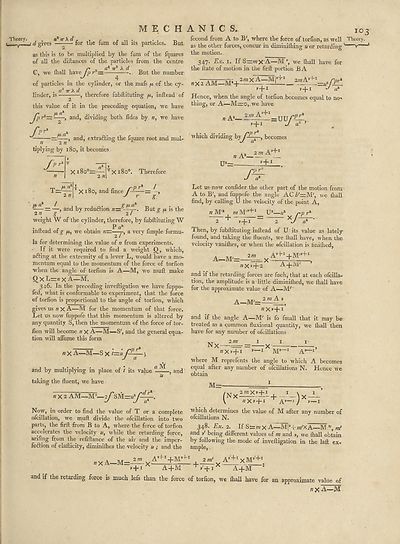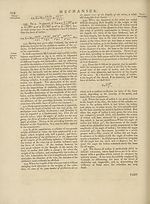Encyclopaedia Britannica, or, a Dictionary of arts, sciences, and miscellaneous literature : enlarged and improved. Illustrated with nearly six hundred engravings > Volume 13, MAT-MIC
(111) Page 103
Download files
Complete book:
Individual page:
Thumbnail gallery: Grid view | List view

Theory.
i d gives —for the fum of all its particles.
MECHANICS.
But
IO3
as this is to be multiplied by the fum of the fquares
of all the diftances of the particles from the centre
But the number:
f {
G, we (hall have fp r'1 —
A d
fecond from A to B', where the force of torfion, as well Theory,
as the other forces, concur in diminifhing u or retarding
the motion..
347. Ex. 1. If S=rwX A—M we (hall have for
the date of motion in the fir ft portion BA
of particles in the cylinder, or the mafs ^ of the cy- «X2AM—M*-j-
linder, is —^ , therefore fubflituting ft, inftead of
2/«XA—M^1
this value of it in the preceding equation, we have
LC (l*
Jp r1— ——, and, dividing both fides by «, we have
fpr'
■ —, and, ext raffing the fquare root and mul-
n 2 n 0
tiplying by 180, it becomes
v-j-l v-f-1 ^ a*
Hence, when the angle of torfion becomes equal to no->
thing, or A-—M—o, we have
2/«A,'('1
1 7+!
n A1
2 m
A^1
>p r
v + i
r,p r*
= UU/,/i
J a
which dividing hyJ~—, becomes
2 w Ay+I
n A1—J
X1800
2 n
Ul—-
y-f-l
X1800. Therefore
riL
J a*
T-
p. a
2 n
T X 180, and fince^-—
p rz
—— rr —, and by reduffion But r tt is the
mg1 J 2/ 6
weight W of the cylinder, therefore, by fubftituting W
.Pa*
inftead of g p, we obtain n———, a very fimple formu¬
la for determining the value of n from experiments.
* If it were required to find a weight (^, which,
affing at the extremity of a lever L, would have a mo¬
mentum equal to the momentum of the force of torfion
when the angle of torfion is A—M, we muft make
QX L—a X A—M.
346. In the preceding inveftigation we have fuppo-
fed, what is conformable to experiment, that the force
of torfion is proportional to the angle of torfion, which
gives us n X A—M for the momentum of that force.
Let us now fuppofe that this momentum is altered by
any quantity S, then the momentum of the force of tor¬
fion will become n X A—M—S', and the general equa¬
tion will aflume this form
n X A—M—S X "t—u :
J a
and by multiplying in place of / its value
taking the fluent, we have
« X 2 AM—M2—2/^SM—
Now, in order to find the value of T or a complete
ofcillation, we muft divide the ofcillation into two
parts, the firft from B to A, where the force of torfion
accelerates the velocity a, while the retarding force,
Let us now confider the other part of the motion from
A to B', and fuppofe the angle AC Z/urM', we (hall
find, by calling U the velocity of the point A,
n M7* m M'v+1 U*—a* rp r*
~+-,+r-=-—
Then, by fubftituting inftead of U its value as lately
found, and taking the fluents, we (hall have, w hen the
velocity vaniflies, or when the ©fcillation is tmifhed,
A—M'=-
2m
A11 i_I 4-M,,’+i
X - ^
«Xv + 2 A-J-lVi'
and if the retarding forces are fuch, that at each ofcilla¬
tion, the amplitude is a little diminilhed, we (hall have
for the approximate value of A—M?
»X*+I
and if the angle A—M' is fo fmall that it may be
treated as a common fluxional quantity, we (hall then
have for any number of ofcillations
NX
= X
aM
■, and
v—1 Mv—1 Ay
where M reprefents the angle to which A becomes
equal after any number of ofcillations N. Hence we
obtain
M—-
f y 2 ffl X ^ “f" I
Nx — +
^ «X» + I
1 \ 1
7 - )X
A”-1 } v—1
which determines the value of M after any number of
ofcillations N.
348. Ex. 2. If S=mx A—M]*1; - m'X A—M V/, m'
- - . o. , and being different values of and y, we (hall obtain
ari.mg trom the refiftance of the air and the imper- by following the mode of inveftigation in the laft ex-
feet ion of elafticity, diminiflies the velocity u ; and the ample,
. n/r 2 m A*1 1
n X A—M=r x
» + A-f-M
+M’
t-i
+
2m' Ay+I XM11^1
+1 A-fM
and if the retarding force is much lefs than the force of torfion, we (hall have for an approximate value of
/*X-A—M
i d gives —for the fum of all its particles.
MECHANICS.
But
IO3
as this is to be multiplied by the fum of the fquares
of all the diftances of the particles from the centre
But the number:
f {
G, we (hall have fp r'1 —
A d
fecond from A to B', where the force of torfion, as well Theory,
as the other forces, concur in diminifhing u or retarding
the motion..
347. Ex. 1. If S=rwX A—M we (hall have for
the date of motion in the fir ft portion BA
of particles in the cylinder, or the mafs ^ of the cy- «X2AM—M*-j-
linder, is —^ , therefore fubflituting ft, inftead of
2/«XA—M^1
this value of it in the preceding equation, we have
LC (l*
Jp r1— ——, and, dividing both fides by «, we have
fpr'
■ —, and, ext raffing the fquare root and mul-
n 2 n 0
tiplying by 180, it becomes
v-j-l v-f-1 ^ a*
Hence, when the angle of torfion becomes equal to no->
thing, or A-—M—o, we have
2/«A,'('1
1 7+!
n A1
2 m
A^1
>p r
v + i
r,p r*
= UU/,/i
J a
which dividing hyJ~—, becomes
2 w Ay+I
n A1—J
X1800
2 n
Ul—-
y-f-l
X1800. Therefore
riL
J a*
T-
p. a
2 n
T X 180, and fince^-—
p rz
—— rr —, and by reduffion But r tt is the
mg1 J 2/ 6
weight W of the cylinder, therefore, by fubftituting W
.Pa*
inftead of g p, we obtain n———, a very fimple formu¬
la for determining the value of n from experiments.
* If it were required to find a weight (^, which,
affing at the extremity of a lever L, would have a mo¬
mentum equal to the momentum of the force of torfion
when the angle of torfion is A—M, we muft make
QX L—a X A—M.
346. In the preceding inveftigation we have fuppo-
fed, what is conformable to experiment, that the force
of torfion is proportional to the angle of torfion, which
gives us n X A—M for the momentum of that force.
Let us now fuppofe that this momentum is altered by
any quantity S, then the momentum of the force of tor¬
fion will become n X A—M—S', and the general equa¬
tion will aflume this form
n X A—M—S X "t—u :
J a
and by multiplying in place of / its value
taking the fluent, we have
« X 2 AM—M2—2/^SM—
Now, in order to find the value of T or a complete
ofcillation, we muft divide the ofcillation into two
parts, the firft from B to A, where the force of torfion
accelerates the velocity a, while the retarding force,
Let us now confider the other part of the motion from
A to B', and fuppofe the angle AC Z/urM', we (hall
find, by calling U the velocity of the point A,
n M7* m M'v+1 U*—a* rp r*
~+-,+r-=-—
Then, by fubftituting inftead of U its value as lately
found, and taking the fluents, we (hall have, w hen the
velocity vaniflies, or when the ©fcillation is tmifhed,
A—M'=-
2m
A11 i_I 4-M,,’+i
X - ^
«Xv + 2 A-J-lVi'
and if the retarding forces are fuch, that at each ofcilla¬
tion, the amplitude is a little diminilhed, we (hall have
for the approximate value of A—M?
»X*+I
and if the angle A—M' is fo fmall that it may be
treated as a common fluxional quantity, we (hall then
have for any number of ofcillations
NX
= X
aM
■, and
v—1 Mv—1 Ay
where M reprefents the angle to which A becomes
equal after any number of ofcillations N. Hence we
obtain
M—-
f y 2 ffl X ^ “f" I
Nx — +
^ «X» + I
1 \ 1
7 - )X
A”-1 } v—1
which determines the value of M after any number of
ofcillations N.
348. Ex. 2. If S=mx A—M]*1; - m'X A—M V/, m'
- - . o. , and being different values of and y, we (hall obtain
ari.mg trom the refiftance of the air and the imper- by following the mode of inveftigation in the laft ex-
feet ion of elafticity, diminiflies the velocity u ; and the ample,
. n/r 2 m A*1 1
n X A—M=r x
» + A-f-M
+M’
t-i
+
2m' Ay+I XM11^1
+1 A-fM
and if the retarding force is much lefs than the force of torfion, we (hall have for an approximate value of
/*X-A—M
Set display mode to:
![]() Universal Viewer |
Universal Viewer | ![]() Mirador |
Large image | Transcription
Mirador |
Large image | Transcription
Images and transcriptions on this page, including medium image downloads, may be used under the Creative Commons Attribution 4.0 International Licence unless otherwise stated. ![]()
| Permanent URL | https://digital.nls.uk/192662605 |
|---|
| Attribution and copyright: |
|
|---|
| Description | Ten editions of 'Encyclopaedia Britannica', issued from 1768-1903, in 231 volumes. Originally issued in 100 weekly parts (3 volumes) between 1768 and 1771 by publishers: Colin Macfarquhar and Andrew Bell (Edinburgh); editor: William Smellie: engraver: Andrew Bell. Expanded editions in the 19th century featured more volumes and contributions from leading experts in their fields. Managed and published in Edinburgh up to the 9th edition (25 volumes, from 1875-1889); the 10th edition (1902-1903) re-issued the 9th edition, with 11 supplementary volumes. |
|---|---|
| Additional NLS resources: |
|

